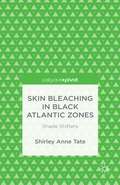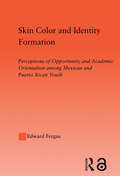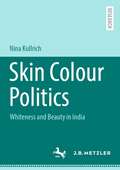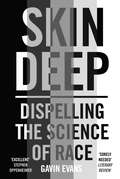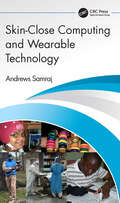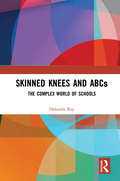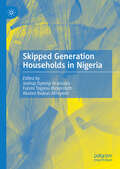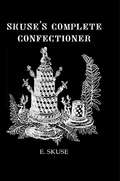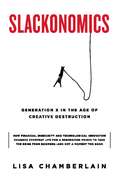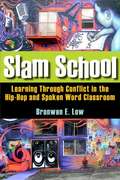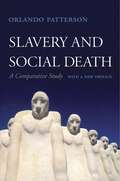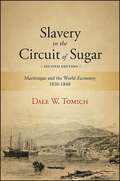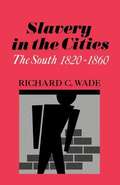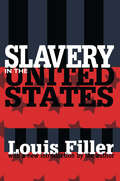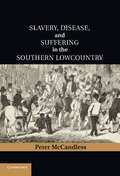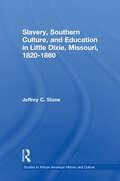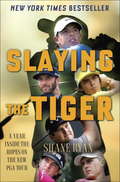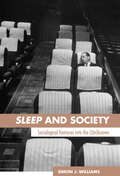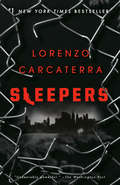- Table View
- List View
Skin Bleaching in Black Atlantic Zones: Shade Shifters
by S. TateThis book's discussion of skin bleaching, lightening and toning in Black Atlantic zones disengages with the usual tropes of Black Nationalism and global white supremacy such as 'the desire to be white', 'low self-esteem' and 'self-hatred' and instead engages with the global multi-billion dollar market in lighter skins with products from local cosmetic and pharmaceutical companies and entrepreneurs. This practice can be for short-term strategic purposes and the production of bleached lightness and new subjectivities through skin shades across Black Atlantic zones - the UK, USA, Caribbean, Latin America and the Africa continent- is also a simultaneous critique of continuing pigmentocracy and darker skin disadvantage. This book seeks to decolonize skin bleaching, lightening and toning by exploring its racialized gender political and libidinal economies in the Black Atlantic. In so doing it moves past the notion that global white supremacy dynamizes the practice to a position where the interaction of colourism and 'post-race' neo-liberal racialization aesthetics becomes the focus.
Skin Color and Identity Formation: Perception of Opportunity and Academic Orientation Among Mexican and Puerto Rican Youth (Latino Communities: Emerging Voices - Political, Social, Cultural and Legal Issues)
by Edward FergusThe focus of this study is on the ways in which skin color moderates the perceptions of opportunity and academic orientation of 17 Mexican and Puerto Rican high school students. More specifically, the study's analysis centered on cataloguing the racial/ethnic identification shifts (or not) in relation to how they perceive others situate them based on skin color.
Skin Colour Politics: Whiteness and Beauty in India
by Nina KullrichThe global practice of skin bleaching is predominantly understood as an internalized legacy of colonialism and an embodiment of Western ideals of beauty. This book offers a new perspective on fair skin preference in India: it challenges the assumption that desires for light skin are always a desire of whiteness. Rather than talking back to the colonial centre, skin colour politics reorganise and reinforce social distinctions in Indian societies, which are neither exclusively local nor global. Based on primary research conducted in Delhi, this multi-dimensional study shows how skin colour intersects with and reproduces other categories of social distinction – primarily gender, class, caste, race, region and religion. It historically embeds fairness as an Indian, precolonial yet transnational ideal of beauty. The bleached body emerges as an active and thus, potentially resistant part of negotiating social status within multiple power relations and complex beauty regimes. By mapping a whole geography of skin colours in India, this book shows how fair skin as a locally embedded beauty norm and whiteness as a global cultural imperative interrelate.
Skin Deep: Journeys in the Divisive Science of Race
by Gavin EvansEverything you need to know about race (but were afraid to ask). MYTH: Early Europeans were white. REALITY: The first Europeans had dark skin, black, curly hair and blue eyes. MYTH: Between 50,000 and 70,000 years ago, a &‘cognitive revolution&’ led to the birth of culture in Europe. REALITY: Modern intelligence evolved tens of thousands of years earlier, leading to the birth of culture in Africa.Does racism have a rational basis in science? In Skin Deep, Gavin Evans tackles head-on the debate that has been raging on internet message boards and in academic journals. No longer limited to the fringe, race-based studies of intelligence have been discussed by thinkers such as Sam Harris and Jordan Peterson. If these studies were true, they would provide an intellectual justification for inequality and discrimination. Examining the latest research on how intelligence develops and laying out new discoveries in genetics, palaeontology, archaeology and anthropology to unearth the truth about our shared past, Skin Deep demolishes the pernicious myth that our race is our destiny and instead reveals what really makes us who we are.
Skin-Close Computing and Wearable Technology
by Andrews SamrajThis book explains the concept of wearable computing, need for wearable technology, its advantages, application areas, state of art developments in this area, required material and technology, possible future applications including cyborg developments and the need for this sphere of influence in the future. The scope encompasses three major components, wearable computing (next generation of conventional computing, ergonomics), wearable technology (medical support, rehabilitation engineering, assistive technology support devices, army/combat usage) and allied technologies (miniature components, reliability, high performance integration, cyber physical systems, robotics). Aids reader to recognize the need and functional operations of a wearable computing device Includes diversified examples and case studies from different domains Presents a hybrid concept relating medical care and augmented reality Illustrates product level description examples and research ideas for future development Introduces various wearable technologies and other related technologies for enabling wearable computing This book is aimed at senior undergraduate, graduate students and researchers in computer and biomedical engineering, bioinstrumentation, biosensors, and assistive technology.
Skinned Knees and ABCs: The Complex World of Schools
by Debarshi RoySkinned Knees and ABCs critically analyzes schools as sites for applied behaviour systems. It delves deep into the origin of various behavioural theories that affect these institutions and utilizes scientific theories in mathematics, behavioural economics and psychology (social, cognitive and educational) to examine the complexities, failures and successes of school systems. The book discusses the complex and chaotic nature of schools and the fundamental psychological constructs which form the basis for curriculum and behavioural designs. It also highlights the problems and peculiarities faced by students, parents and educators and suggests alternatives and solutions through real-life case studies. Drawing on in-depth research and theoretical know-how, the book will be of interest to students, teachers and researchers of school education, organizational behaviour, behavioural sciences and applied psychology. It will also be of interest to parents of school-going children, school management heads, policy makers and educators.
Skipped Generation Households in Nigeria
by Joshua Oyeniyi Aransiola Funmi Togonu-Bickersteth Akanni Ibukun AkinyemiThis volume unpacks the phenomenon of skipped generation households—where children live with their grandparents and without their parents—as they become an increasingly common family dynamic in Nigeria and globally. The skipped generation household's emergence in sub-Saharan Africa has been driven by factors including the HIV/AIDS epidemic, labour-based migration, and ethno-religious conflicts. By examining the data from a national study on skipped generation households in Nigeria, contributions track benefits, opportunities, and effects associated with growing up in these households. Details including academic performance and career aspirations for grandchildren, as well as social-psychological and physical well-being of both them and their grandparents, are explored.
Skizze einer Theorie der Relation
by Christian Papilloud Eva-Maria SchultzeMit Relation in den unterschiedlichen Deklinationen dieses Begriffes als Beziehung, Interaktion, Austausch, Verhältnis usw. wird eine Fundierung der soziologischen Theorie auf der Mikroebene der Zwischenmenschlichkeit nahegelegt, wovon es genüge, deren Emergenz in vorausgesetzten nachfolgenden höheren Stufen nachzuzeichnen, um sie als Wurzel der Gesellschaft zu verstehen. Dabei geht oft die Überlegung verloren, nach der sich eine Gesellschaft auch im Rücken der Akteure herausbilden kann, ohne dass sie es wollen und ohne dass sie daran tatsächlich teilhaben. Im Vergleich zur Forschungsperspektive der relationalen Soziologie und den diversen angegliederten Formen des Interaktionismus in der Soziologie hat Pierre Bourdieu in seinem soziologischen Werk eine solche kritische Position bezogen und kompromisslos für einen makro-relationalen Ansatz in der Soziologie geworben. Damit hat er die Grundlage einer Überlegung zur Relation als Makrobegriff gelegt, der nicht etwa einen alternativen Ansatz in den Bereich der existierenden relationalen Soziologie einführt, sondern als Hauptansatz einer soziologischen Theorie zu verstehen ist. In diesem Band wird dieser Weg sowohl im Kontrast zu der relationalen Soziologie als auch im Kontrast zur Theorie Bourdieus beschritten, woraus eine entsprechende Theorie der Relation für die soziologische Theorie gewonnen wird.
Skulls to the Living, Bread to the Dead: The Day of the Dead in Mexico and Beyond
by Stanley H. Brandes<p>Each October, as the Day of the Dead draws near, Mexican markets overflow with decorated breads, fanciful paper cutouts, and whimsical toy skulls and skeletons. To honor deceased relatives, Mexicans decorate graves and erect home altars. Drawing on a rich array of historical and ethnographic evidence, this volume reveals the origin and changing character of this celebrated holiday. It explores the emergence of the Day of the Dead as a symbol of Mexican and Mexican-American national identity. <p>Skulls to the Living, Bread to the Dead poses a serious challenge to the widespread stereotype of the morbid Mexican, unafraid of death, and obsessed with dying. In fact, the Day of the Dead, as shown here, is a powerful affirmation of life and creativity. Beautifully illustrated, this book is essential for anyone interested in Mexican culture, art, and folklore, as well as contemporary globalization and identity formation.</p>
Skuse'S Complete Confectioner
by SkuseFirst published in 2005. Routledge is an imprint of Taylor & Francis, an informa company.
Slackonomics: Generation X in the Age of Creative Destruction
by Lisa ChamberlainGeneration X grew up in the 1980s, when Alex P. Keaton was going to be a millionaire by the time he was thirty, greed was good, and social activism was deader than disco. Then globalization and the technological revolution came along, changing everything for a generation faced with bridging the analog and digital worlds. Living in a time of “creative destruction” – when an old economic order is upended by a new one – has deeply affected everyday life for this generation; from how they work, where they live, how they play, when they marry and have children to their attitudes about love, humor, happiness, and personal fulfillment. Through a sharp and entertaining mix of pop and alt-culture, personal narrative, and economic analysis, author Lisa Chamberlain shows how Generation X has survived and even thrived in the era of creative destruction, but will now be faced with solving economic and environmental problems on a global scale.
Slam School: Learning Through Conflict in the Hip-hop and Spoken Word Classroom
by Bronwen E. LowIn this study, Low (education, McGill U. , Canada) relates how a white teacher implemented the study of hip-hop and spoken word culture into urban high school language arts classes, which she co-taught and helped develop the curriculum for. She analyzes the dynamics of teaching and learning in these classes to argue that the reasons that teachers and administrators resist introducing hip-hop into curriculum--its complex issues of gender, violence, sexuality, materialism, race, and language--are what make it important pedagogically. She focuses on African American youth in interaction with white youth, teachers, and administrators, describing the student's exploration of poetry performance and writing and their experiences with the language of the hip-hop culture. Annotation ©2011 Book News, Inc. , Portland, OR (booknews. com)
Slang across Societies: Motivations and Construction
by Jim DavieSlang Across Societies is an introductory reference work and textbook which aims to acquaint readers with key themes in the study of youth, criminal and colloquial language practices. Focusing on key questions such as speaker identity and motivations, perceptions of use and users, language variation, and attendant linguistic manipulations, the book identifies and discusses more than 20 in-group and colloquial varieties from no fewer than 16 different societies worldwide. Suitable for advanced undergraduate and postgraduate students working in areas of slang, lexicology, lexicography, sociolinguistics and youth studies, Slang Across Societies brings together extensive research on youth, criminal and colloquial language from different parts of the world.
Slavery and Forced Migration in the Antebellum South
by Damian Alan PargasAmerican slavery in the antebellum period was characterized by a massive wave of forced migration as millions of slaves were moved across state lines to the expanding southwest, scattered locally, and sold or hired out in towns and cities across the South. This book sheds new light on domestic forced migration by examining the experiences of American-born slave migrants from a comparative perspective. Juxtaposing and contrasting the experiences of long-distance, local, and urban slave migrants, it analyzes how different migrant groups anticipated, reacted to, and experienced forced removal, as well as how they adapted to their new homes.
Slavery and Social Death: A Comparative Study, With a New Preface
by Orlando Patterson<p>This is the first full-scale comparative study of the nature of slavery. In a work of prodigious scholarship and enormous breadth, which draws on the tribal, ancient, premodern, and modern worlds, Orlando Patterson discusses the internal dynamics of slavery in sixty-six societies over time. These include Greece and Rome, medieval Europe, China, Korea, the Islamic kingdoms, Africa, the Caribbean islands, and the American South. Slavery is shown to be a parasitic relationship between master and slave, invariably entailing the violent domination of a natally alienated, or socially dead, person. The phenomenon of slavery as an institution, the author argues, is a single process of recruitment, incorporation on the margin of society, and eventual manumission or death. <p>Distinctions abound in this work. Beyond the reconceptualization of the basic master-slave relationship and the redefinition of slavery as an institution with universal attributes, Patterson rejects the legalistic Roman concept that places the "slave as property" at the core of the system. Rather, he emphasizes the centrality of sociological, symbolic, and ideological factors interwoven within the slavery system. Along the whole continuum of slavery, the cultural milieu is stressed, as well as political and psychological elements. Materialistic and racial factors are deemphasized. The author is thus able, for example, to deal with "elite" slaves, or even eunuchs, in the same framework of understanding as fieldhands; to uncover previously hidden principles of inheritance of slave and free status; and to show the tight relationship between slavery and freedom. <p>Interdisciplinary in its methods, this study employs qualitative and quantitative techniques from all the social sciences to demonstrate the universality of structures and processes in slave systems and to reveal cross-cultural variations in the slave trade and in slavery, in rates of manumission, and in the status of freedmen. Slavery and Social Death lays out a vast new corpus of research that underpins an original and provocative thesis.</p>
Slavery in the Circuit of Sugar, Second Edition: Martinique and the World-Economy, 1830-1848 (SUNY Press Open Access)
by Dale W. TomichA classic text long out of print, Slavery in the Circuit of Sugar traces the historical development of slave labor and plantation agriculture in Martinique during the period immediately preceding slave emancipation in 1848. Interpreting these events against the broader background of the world-economy, Dale W. Tomich analyzes the importance of topics such as British hegemony in the nineteenth century, related developments of the French economy, and competition from European beet sugar producers. He shows how slaves' adaptation—and resistance—to changing working conditions transformed the plantation labor regime and the very character of slavery itself. Based on archival sources in France and Martinique, Slavery in the Circuit of Sugar offers a vivid reconstruction of the complex and contradictory interrelations among the world market, the material processes of sugar production, and the social relations of slavery. In this second edition, Tomich includes a new introduction in which he offers an explicit discussion of the methodological and theoretical issues entailed in developing and extending the world-systems perspective and clarifies the importance of the approach for the study of particular histories.This book is freely available in an open access edition thanks to Knowledge Unlatched—an initiative that provides libraries and institutions with a centralized platform to support OA collections and from leading publishing houses and OA initiatives. Learn more at the Knowledge Unlatched website at: https://www.knowledgeunlatched.org/, and access the book online at the SUNY Open Access Repository at http://hdl.handle.net/20.500.12648/7131.
Slavery in the Cities: The South 1820-1860
by Richard C. WadeAttempts to show what happened to slavery in an urban environment and to reconstruct the texture of life of the Negroes who lived in bondage in the cities.
Slavery in the Late Roman World, AD 275–425
by Kyle HarperCapitalizing on the rich historical record of late antiquity, and employing sophisticated methodologies from social and economic history, this book reinterprets the end of Roman slavery. Kyle Harper challenges traditional interpretations of a transition from antiquity to the Middle Ages, arguing instead that a deep divide runs through 'late antiquity', separating the Roman slave system from its early medieval successors. In the process, he covers the economic, social and institutional dimensions of ancient slavery and presents the most comprehensive analytical treatment of a pre-modern slave system now available. By scouring the late antique record, he has uncovered a wealth of new material, providing fresh insights into the ancient slave system, including slavery's role in agriculture and textile production, its relation to sexual exploitation, and the dynamics of social honor. By demonstrating the vitality of slavery into the later Roman empire, the author shows that Christianity triumphed amidst a genuine slave society.
Slavery in the United States
by Louis FillerSlavery in the United States clarifies the institution of slavery in its historical context. Filler avoids the all too prevalent literary attitude of either treating slavery as an unmitigated nightmare from the past, or regarding it as a way of life which warmly repaid slave and slaveholder. He does not reduce the issue to one of fact and figures, nor does he inject endless hypotheses and analogues. Rather, this finely etched volume encompasses the human implications of slavery and its practices. It emphasizes the distinguished and disreputable elements on both sides of the slavery relationship, and in every part of the United States.Slavery offers peculiar challenges to the student of American life, past and present. It is unrealistic to avoid the human implications of slavery and its practice. It is equally unhelpful to assume glib and partial viewpoints with respect to so all-embracing a system as slavery became. The cause of progress, no less than social science, is not advanced by indifference to patent facts. The civil libertarian who romanticizes black people indiscriminately, and lumps Jefferson Davis with Simon Legree may win popularity with enthusiasts and ideologues. But they will soon find themselves quaint and outmoded.The author reminds us that "the safest approach to slavery is to determine what the institution meant to the country at large; why it flourished as it did, and how it came to be opposed and overthrown." The work includes high quality often neglected readings that permit the reader to form his or her own views. It reveals the best writing on all aspects of the slavery issue, as well as analytic summations by contemporary historians and social researchers.
Slavery, Disease, and Suffering in the Southern Lowcountry
by Peter MccandlessOn the eve of the Revolution, the Carolina lowcountry was the wealthiest and unhealthiest region in British North America. Slavery, Disease, and Suffering in the Southern Lowcountry argues that the two were intimately connected: both resulted largely from the dominance of rice cultivation on plantations using imported African slave labor. This development began in the coastal lands near Charleston, South Carolina, around the end of the seventeenth century. Rice plantations spread north to the Cape Fear region of North Carolina and south to Georgia and northeast Florida in the late colonial period. The book examines perceptions and realities of the lowcountry disease environment; how the lowcountry became notorious for its 'tropical' fevers, notably malaria and yellow fever; how people combated, avoided or perversely denied the suffering they caused; and how diseases and human responses to them influenced not only the lowcountry and the South, but the United States, even helping to secure American independence.
Slavery, Southern Culture, and Education in Little Dixie, Missouri, 1820-1860 (Studies in African American History and Culture)
by Jeffrey C. StoneThis dissertation examines the cultural and educational history of central Missouri between 1820 and 1860, and in particular, the issue of master-slave relationships and how they affected education (broadly defined as the transmission of Southern culture). Although Missouri had one of the lowest slave populations during the Antebellum period, Central Missouri - or what became known as Little Dixie - had slave percentages that rivaled many regions and counties of the Deep South. However, slaves and slave owners interacted on a regular basis, which affected cultural transmission in the areas of religion, work, and community. Generally, slave owners in Little Dixie showed a pattern of paternalism in all these areas, but the slaves did not always accept their masters' paternalism, and attempted to forge a life of their own.
Slavoj Žižek
by Tony Wall David PerrinŽižek demands we take a long, hard look at the painful reality of education in contemporary capitalist society, and to actively seek out its 'trouble in paradise': Why is it education is supposedly failing to meet the demands of our society? Why is it there are record levels of stress for teachers? Why is it there is a record level of complaints from our university students? How is it now possible to compare a higher education course with a vacuum cleaner, toaster or television? This book illuminates aspects of Žižek's ideas which sheds light into these modern challenges and tensions in education, and considers alternative ways forward. Though Žižek frustrates as much as he inspires with his own recipe of Lacan, Hegel and Marx, this book aims to give an entry route into Žižekian critique of education, a topic area he very rarely directly talks about.
Slaying the Tiger: A Year Inside the Ropes on the New PGA Tour
by Shane RyanNEW YORK TIMES BESTSELLER * In Slaying the Tiger, one of today's boldest young sportswriters spends a season inside the ropes alongside the rising stars who are transforming the game of golf. For more than a decade, golf was dominated by one galvanizing figure: Eldrick "Tiger" Woods. But as his star has fallen, a new, ambitious generation has stepped up to claim the crown. Once the domain of veterans, golf saw a youth revolution in 2014. In Slaying the Tiger, Shane Ryan introduces us to the volatile, colorful crop of heirs apparent who are storming the barricades of this traditionally old-fashioned sport. As the golf writer for Bill Simmons's Grantland, Shane Ryan is the perfect herald for the sport's new age. In Slaying the Tiger, he embeds himself for a season on the PGA Tour, where he finds the game far removed from the genteel rhythms of yesteryear. Instead, he discovers a group of mercurial talents driven to greatness by their fear of failure and their relentless perfectionism. From Augusta to Scotland, with an irreverent and energetic voice, Ryan documents every transcendent moment, every press tent tirade, and every controversy that made the 2014 Tour one of the most exciting and unpredictable in recent memory. Here are indelibly drawn profiles of the game's young guns: Rory McIlroy, the Northern Irish ace who stepped forward as the game's next superstar; Patrick Reed, a brash, boastful competitor with a warrior's mentality; Dustin Johnson, the brilliant natural talent whose private habits sabotage his potential; and Jason Day, a resilient Aussie whose hardscrabble beginnings make him the Tour's ultimate longshot. Here also is the bumptious Bubba Watson, a devout Christian known for his unsportsmanlike outbursts on the golf course; Keegan Bradley, a flinty New Englander who plays with a colossal chip on his shoulder; twenty-one-year-old Jordan Spieth, a preternaturally mature Texan carrying the hopes of the golf establishment; and Rickie Fowler, the humble California kid striving to make his golf speak louder than his bright orange clothes. Bound by their talent, each one hungrier than the last, these players will vie over the coming decade for the right to be called the next king of the game. Golf may be slow to change, but in 2014, the wheels were turning at a feverish pace. Slaying the Tiger offers a dynamic snapshot of a rapidly evolving sport.Praise for Slaying the Tiger"This book is going to be controversial. There is no question about it. . . . It is the most unvarnished view of the tour--the biggest tour in the world--that I've ever read. And it's not close."--Gary Williams, Golf Channel"A must-read for PGA Tour fans from the casual to the most dedicated . . . This book is certain to be as important to this era as [John] Feinstein's [A Good Walk Spoiled] was two decades ago. . . . A well-researched, in-depth look at the men who inhabit the highest levels of the game."--Examiner.com "A masterfully written account of an important time in golf history."--Adam Fonseca, Golf Unfiltered "Absolutely marvelous . . . Ryan's writing flows and his reporting turns pages for you."--Kyle Porter, CBS Sports "A riveting read."--Library Journal "Ryan's fresh look is just what we golfer/readers want."--Curt Sampson, New York Times bestselling author of Hogan "Ryan does a fantastic job painting a thoughtful and accurate portrait of the new crop of heirs apparent."--Stephanie Wei, Wei Under ParFrom the Hardcover edition.
Sleep and Society: Sociological Ventures into the Un(known)
by Simon J. WilliamsExploring the sociological aspects of sleep and their links to current health debates, this unique text discusses why sleep has been so neglected in sociological literature and examines significant modern issues such as: the 24-hour society sleep and work homelessness dream analysis the medicalization and commodification of sleep. Written by a key international figure in medical sociology, this is the first sociological examination of sleep, making it important reading for academics and advanced students of medical sociology, health studies, and sociology, as well as for professionals and policy makers involved in the area.
Sleepers
by Lorenzo CarcaterraNEW YORK TIMES BESTSELLER * For fans of Game of Silence, Sleepers is the extraordinary true story of four men who take the law into their own hands. This is the story of four young boys. Four lifelong friends. Intelligent, fun-loving, wise beyond their years, they are inseparable. Their potential is unlimited, but they are content to live within the closed world of New York City's Hell's Kitchen. And to play as many pranks as they can on the denizens of the street. They never get caught. And they know they never will. Until one disastrous summer afternoon. On that day, what begins as a harmless scheme goes horrible wrong. And the four find themselves facing a year's imprisonment in the Wilkinson Home for Boys. The oldest of them is fifteen, the youngest twelve. What happens to them over the course of that year--brutal beatings, unimaginable humiliation--will change their lives forever. Years later, one has become a lawyer. One a reporter. And two have grown up to be murderers, professional hit men. For all of them, the pain and fear of Wilkinson still rages within. Only one thing can erase it. Revenge. To exact it, they will twist the legal system. Commandeer the courtroom for their agenda. Use the wiles they observed on the streets, the violence they learned at Wilkinson. If they get caught this time, they only have one thing left to lose: their lives. Praise for Sleepers "Undeniably powerful, an enormously affecting and intensely human story . . . Sleepers is a thriller, to be sure, but it is equally a wistful hymn to another age."--The Washington Post Book World "A gut-wrenching piece of work . . . [Lorenzo] Carcaterra's graphic narrative grips like gunfire in a dark alley."--The Atlanta Journal-Constitution "A terrifying account of brutality and retribution, searing in its emotional truth, peopled with murderers, sadists, and thugs, but biblical in its passion and scope."--People "Sleepers is so many things: a Dickensian portrait of coming of age in Hell's Kitchen, a terrifying and heartbreaking account of the brutalization of youth, a shocking--and disturbingly satisfying--climax worthy of the finest suspense novel. A brilliant, troubling, important book."--Jonathan Kellerman "Compelling."--USA TodayFrom the Paperback edition.
